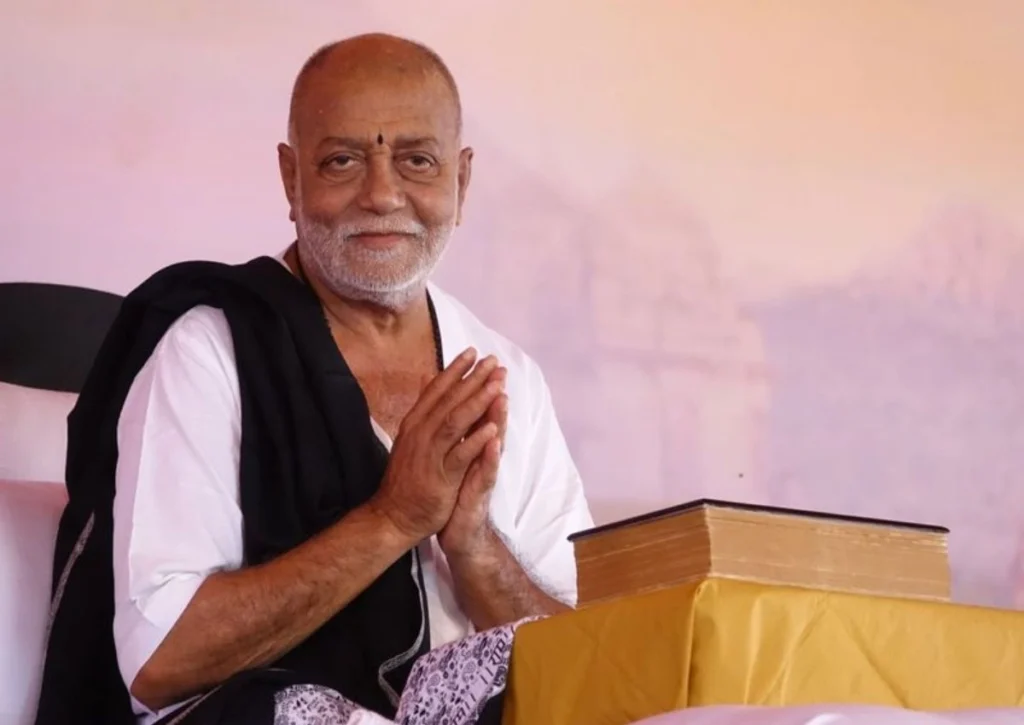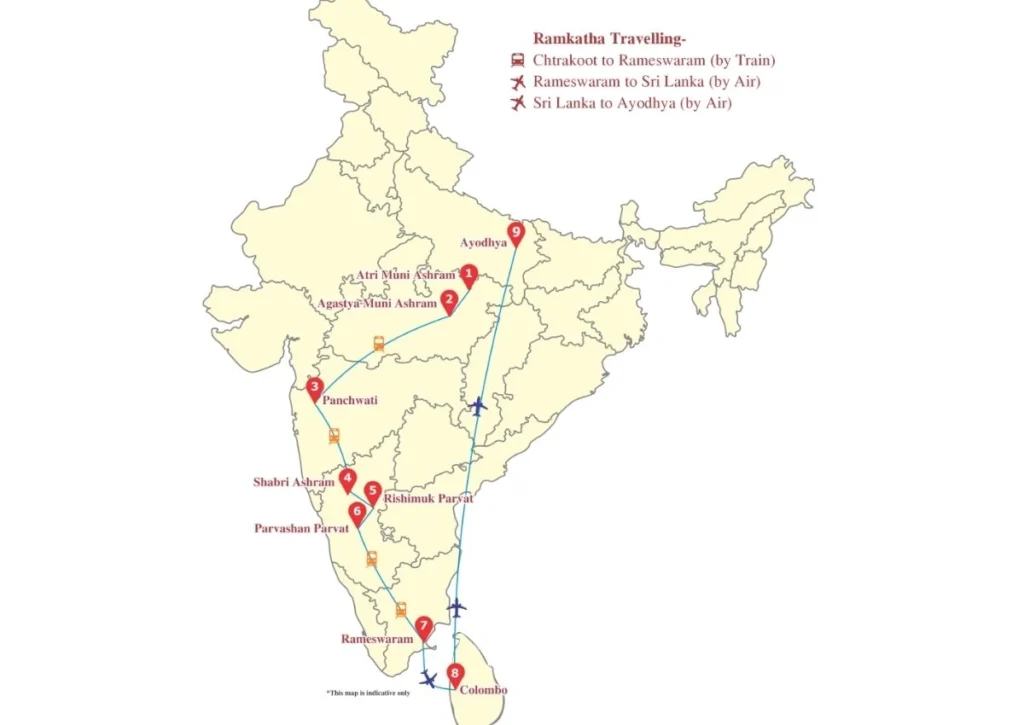Manas Ram Yatra is a soulful journey for the soul and is known not to be the journey of a physical pilgrimage but also of the soul, which is one of the rarest opportunities for a devotee to experience during which one can literally allow themselves to follow the great path of Lord Rama in solidarity in your mind and spirit while living in exile known as the Ram Van Gaman Path. It is a devotional journey that combines the spatial reality of the Indian subcontinent with the timeless story of the Ramayana, in particular Tulsidas’s acclaimed Ramcharitmanas, thus the name, Manas Yatra.
(Organised by Morari Bapu, who is a renowned exponent of the Ram Charit Manas)

This Yatra, which is well known and established for many decades all over the world by spiritual organizations, like Chitrakutdham Talgajarda, for its brilliant treatment of Katha, is unique in a way that it is a convoy Pilgrimage Yatra with non-stop Spiritual Discourse. The telling of the divine story is deliberately enacted and recited at the very places the epic incidents are said to have occurred. This joining of scripture and sacred geography turns a religious discourse into a traveling, multi-destination, spiritual event in which pilgrims can see the epic saga come alive.
The Spiritual Foundation: The Ram Van Gaman Path
The 14 years of exile (vanvas) is perhaps the most defining phase in Lord Rama’s life, where his dharma, patience, and determination are put to the test. Ram Van Gaman Path is hence not just a journey; it is the living proof of his capability to keep a promise, which defines the nature of Maryada Purushottam (the perfect man). Traversing this trail is a form of worship, and a pilgrim is said to imbibe the lessons of sacrifice, devotion, and purity (Dharma) that Rama, Sita, and Lakshmana lived by.
Not beginning in Ayodhya, his home, but at Chitrakoot, in Madhya Pradesh, the first great encampment stop where Rama set up the hermitage with Sita and Lakshman, the sojourn is then actually established. This place, which comprises the Atri Muni Ashram and the spot identified with Sati Anusuya, is where the pilgrims find their own separation and commitment to the journey of the spirit. The ground trodden by the Divine feet of the exiles is sanctified along the way, and to read the story at these sites is said to bestow abundant spiritual merit that cleanses the soul and gives one an embodied sense of epic.
A Sacred Itinerary: Key Locations of the Epic

A full Manas Ram Yatra itinerary will take followers on a rigorous, multiple-state journey of thousands of kilometers that carefully connects the most powerful sites associated with the Ramayana narrative from Central India to the island-based country of Sri Lanka.
Central and Western Chapters
The journey is brisk, from Chitrakoot to the ashram of Agstya Muni Ashram (Kumbhaj Rishi Ashram). In addition to receiving the Agastya Ashrama, and guidance by the most vital and revered sage Agastya, Rama also obtains astral weaponry for the mission that awaits him from Lakshmi’s daughter, the goddess who calls herself Vibhishana but who really represents Jagdamba. The pilgrimage then moves dramatically westward to Panchwati in Nashik, Maharashtra. This is where the worst tragedy of the exile, the abduction of Sita by the demon king Ravana, takes place. The recitation of the katha of separation and the initiation of Rama’s search for Sita at this very location engenders a great emotional response in the devotees.
The Kishkindha Alliance
The Yatra takes place southward in the then fictitious land of Kishkindha in Karnataka. This is where the pilgrims take a detour to Shabri Ashram, honoring the tribal woman Shabri, whose straightforward devotion to Rama, expressed in offering tasted berries, resonates the idea of salvation through bhakti (devotion), no matter what one’s place in social strata.
Important political and military alliances were formed in this area. Rishimukh Parvat and Prasravan / Malyavant Parvat are the destinations of pilgrims near Hampi. Rishimukh Parvat is where Rama and Hanuman met Sugriva to form the monkey army that will rescue Sita from Ravana. Malyavant Parvat is generally considered to be the place where the monsoon season Rama rested to plan his strategy for the future in his mind and in his sorrow for lost Sita when he was a Renunciate.
The Path to Lanka and Final Victory
The journey culminates in the South, arriving at Rameshwaram in Tamil Nadu. Rameshwaram is the holy peninsula where Lord Rama offered prayers on a Shivlingam before building the Setu (bridge) to Lanka. It is a testament to a powerful moment in Rama’s life, expressing his admiration for Lord Siva, and one of the greatest pilgrimage sites in Hinduism.
On its most elaborate itinerary, the pilgrimage extends off the coast to Colombo, Sri Lanka, covering sites tied to the last, ultimate battle, the defeat of Ravana, the joyous recovery of Sita. This portion of the route represents the conclusive conquest of Dharma over Adharma.
The Homecoming
The Yatra is fulfilled in the last stage of the journey to return to Ayodhya Dham in Uttar Pradesh as the rightful deity and king of Lord Rama. This return, like the jubilant Pattabhisheka (crowning), ends on a high note for the tired pilgrim, and contemplates the wheel of life and the ultimate victory of truth.
The Synergy of Katha and Yatra
What makes the Manas Ram Yatra special is its unique character: the uninterrupted fusion of spiritual travels and discourses on the spiritual. The spiritual mentor guides the pilgrims, telling the individual chapters from the Ramcharitmanas pertaining to the place they are traveling to. This place-specific recitation is not only natural but profound, for it “grounds” the scriptural teachings from the world of immortal principles into tangible, sensible realities.
For example, the teachings on loyalty and brotherhood might be emphasized here in Chitrakoot, whilst the message on Hanuman’s service is preached in the vicinity of Rishimukh Parvat. The rigors of the long trek, continual sudden movement, and restless inertia become themselves a sort of penance, and help the travelers better identify with the theme of sacrifice that defines Rama’s wanderings. Download and listen to Bharatanatyam songs, Sunday school songs, rekha cards, and more. Participants are told to see the obstacles that the travel throws up as an element of the general tapasya (penance) of the pilgrimage.
Also check:- Aman Gupta: The Brain Behind boAt’s Wave of Success
Navigating the Logistics of a Modern Pilgrimage
Coordinating a Manas Ram Yatra of this magnitude is a Herculean task. Because of distances involved and rigid itineraries, travelers normally have two main ways to go:
- Pilgrimage at Your Own Pace: Believers make arrangements for their own travel and lodging, and attend Ram Katha at a number of locations of their choice. This involves some personal planning, but still gives you some flexibility.
- Special Chartered Travel: Organizers often arrange for a special train (such as the Bharat Gaurav Special train) for a more cohesive trip. Package price includes AC train travel, vegetarian meals served on board, arrangements for washing and changing at hotels close to the stations, and AC bus rides to and from the katha pandals.
This all-inclusive approach to travel, convenient though it may be, is, with the recognition of the organizing group, an extraordinarily demanding trek, at the end of which participants are expected not only to be physically fit but mentally prepared to overcome the hazards of unrelenting, high-speed travel through several varying climactic zones. So the Manas Ram Yatra is a challenge of faith as well as stamina, and thus, it is the dedicated pilgrim alone who is able to attain a spiritual treasure that enriches his soul for a lifetime. It’s not that the journey is solely about places; it’s about living out Lord Rama’s journey to the forest.




